An Analysis of Economic, Gender, and Racial Inequalities in Society
VerifiedAdded on 2022/08/14
|11
|2326
|12
Essay
AI Summary
This essay provides a comprehensive analysis of various forms of inequality, including economic, gender, and racial disparities. It begins by defining inequality and its impact on society, followed by an exploration of gender inequality, focusing on the gender pay gap in New Zealand. The essay delves into the current interventions in New Zealand aimed at closing the gender pay gap and suggests improved interventions for reducing gender pay inequality. Additionally, the essay addresses racial inequality and its effects on society, highlighting the complexities and mechanisms that perpetuate these disparities. The study draws on various research and statistical data to support its arguments, providing a detailed understanding of the multifaceted nature of inequality and its implications.
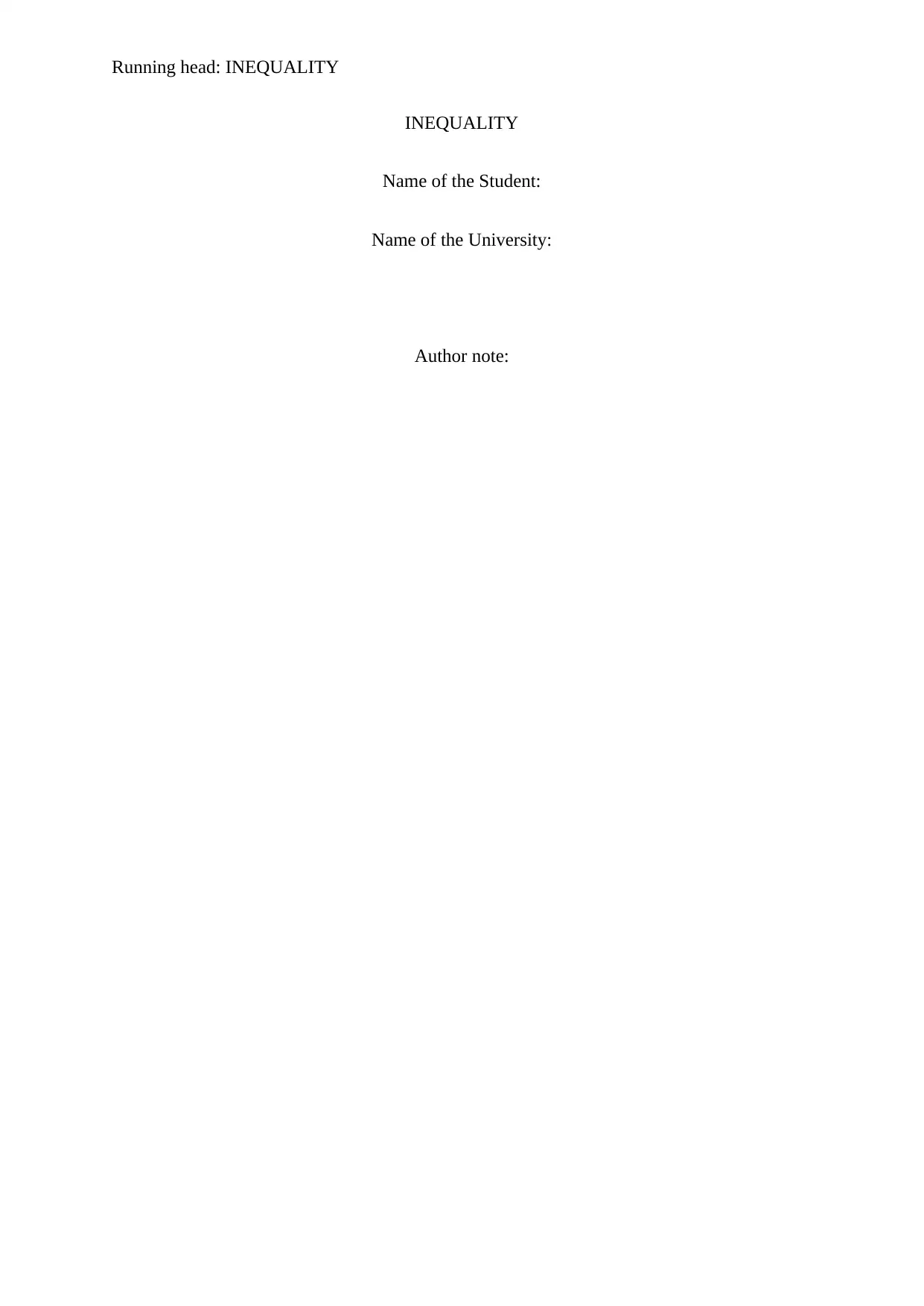
Running head: INEQUALITY
INEQUALITY
Name of the Student:
Name of the University:
Author note:
INEQUALITY
Name of the Student:
Name of the University:
Author note:
Paraphrase This Document
Need a fresh take? Get an instant paraphrase of this document with our AI Paraphraser
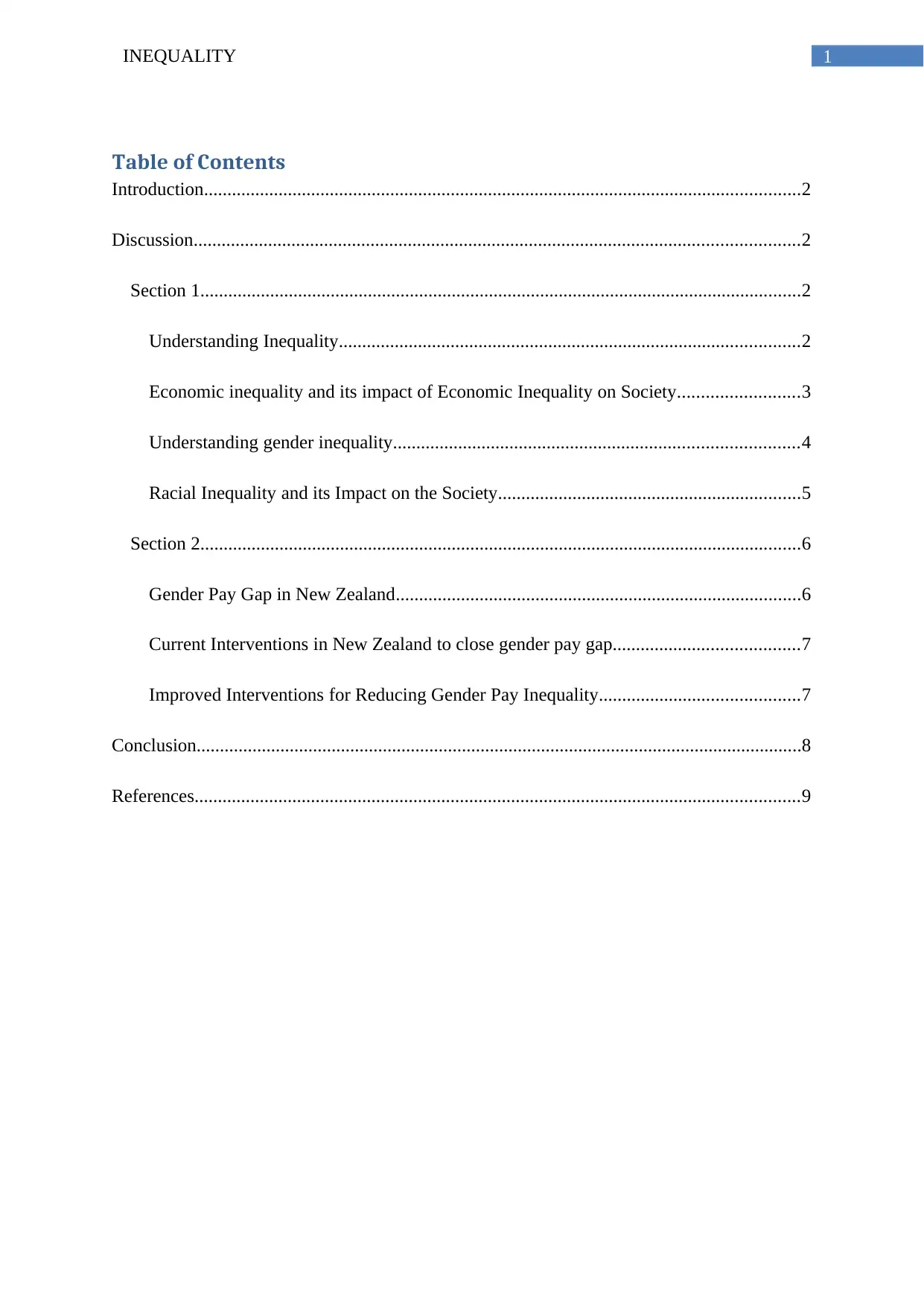
1INEQUALITY
Table of Contents
Introduction................................................................................................................................2
Discussion..................................................................................................................................2
Section 1.................................................................................................................................2
Understanding Inequality...................................................................................................2
Economic inequality and its impact of Economic Inequality on Society..........................3
Understanding gender inequality.......................................................................................4
Racial Inequality and its Impact on the Society.................................................................5
Section 2.................................................................................................................................6
Gender Pay Gap in New Zealand.......................................................................................6
Current Interventions in New Zealand to close gender pay gap........................................7
Improved Interventions for Reducing Gender Pay Inequality...........................................7
Conclusion..................................................................................................................................8
References..................................................................................................................................9
Table of Contents
Introduction................................................................................................................................2
Discussion..................................................................................................................................2
Section 1.................................................................................................................................2
Understanding Inequality...................................................................................................2
Economic inequality and its impact of Economic Inequality on Society..........................3
Understanding gender inequality.......................................................................................4
Racial Inequality and its Impact on the Society.................................................................5
Section 2.................................................................................................................................6
Gender Pay Gap in New Zealand.......................................................................................6
Current Interventions in New Zealand to close gender pay gap........................................7
Improved Interventions for Reducing Gender Pay Inequality...........................................7
Conclusion..................................................................................................................................8
References..................................................................................................................................9
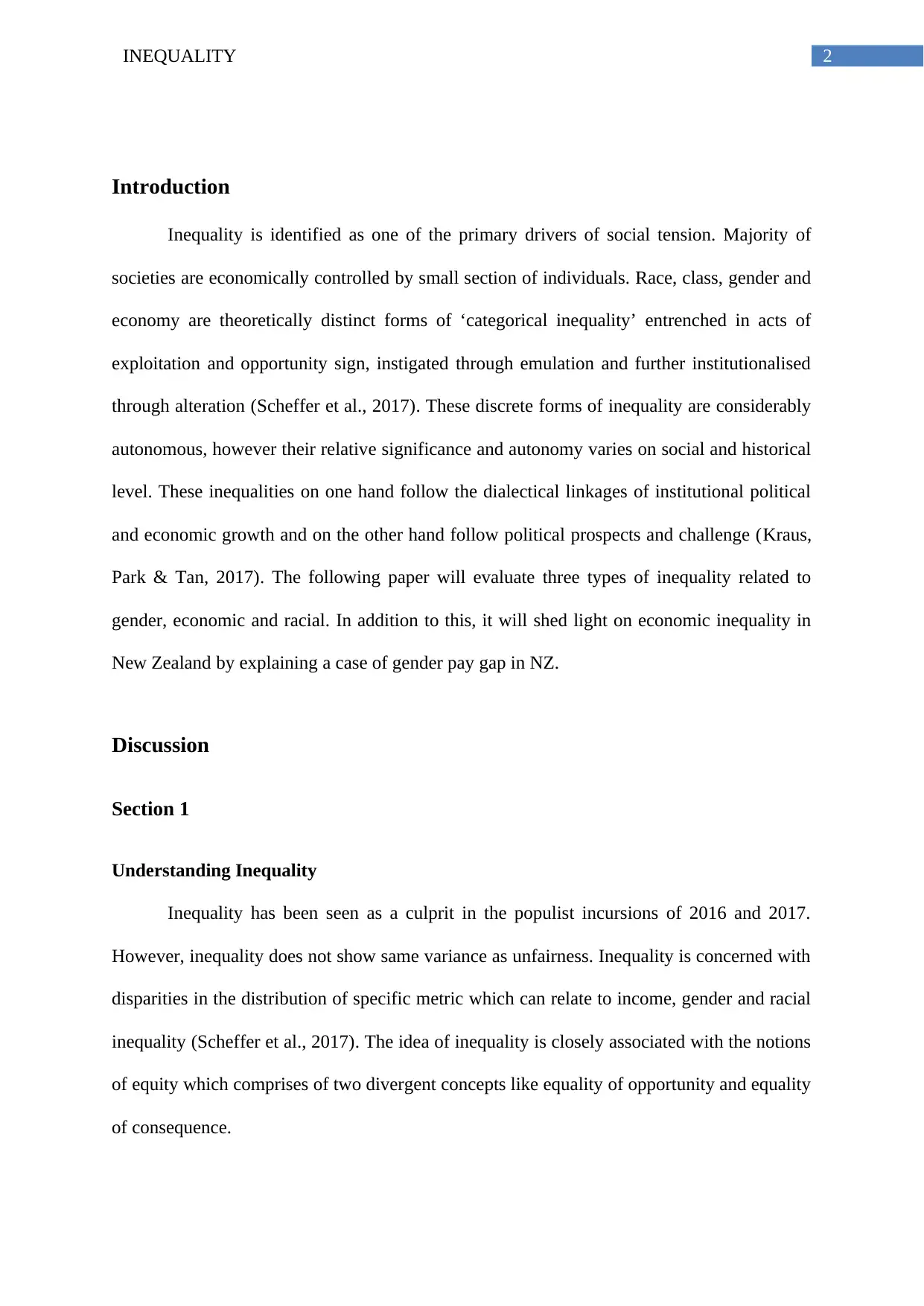
2INEQUALITY
Introduction
Inequality is identified as one of the primary drivers of social tension. Majority of
societies are economically controlled by small section of individuals. Race, class, gender and
economy are theoretically distinct forms of ‘categorical inequality’ entrenched in acts of
exploitation and opportunity sign, instigated through emulation and further institutionalised
through alteration (Scheffer et al., 2017). These discrete forms of inequality are considerably
autonomous, however their relative significance and autonomy varies on social and historical
level. These inequalities on one hand follow the dialectical linkages of institutional political
and economic growth and on the other hand follow political prospects and challenge (Kraus,
Park & Tan, 2017). The following paper will evaluate three types of inequality related to
gender, economic and racial. In addition to this, it will shed light on economic inequality in
New Zealand by explaining a case of gender pay gap in NZ.
Discussion
Section 1
Understanding Inequality
Inequality has been seen as a culprit in the populist incursions of 2016 and 2017.
However, inequality does not show same variance as unfairness. Inequality is concerned with
disparities in the distribution of specific metric which can relate to income, gender and racial
inequality (Scheffer et al., 2017). The idea of inequality is closely associated with the notions
of equity which comprises of two divergent concepts like equality of opportunity and equality
of consequence.
Introduction
Inequality is identified as one of the primary drivers of social tension. Majority of
societies are economically controlled by small section of individuals. Race, class, gender and
economy are theoretically distinct forms of ‘categorical inequality’ entrenched in acts of
exploitation and opportunity sign, instigated through emulation and further institutionalised
through alteration (Scheffer et al., 2017). These discrete forms of inequality are considerably
autonomous, however their relative significance and autonomy varies on social and historical
level. These inequalities on one hand follow the dialectical linkages of institutional political
and economic growth and on the other hand follow political prospects and challenge (Kraus,
Park & Tan, 2017). The following paper will evaluate three types of inequality related to
gender, economic and racial. In addition to this, it will shed light on economic inequality in
New Zealand by explaining a case of gender pay gap in NZ.
Discussion
Section 1
Understanding Inequality
Inequality has been seen as a culprit in the populist incursions of 2016 and 2017.
However, inequality does not show same variance as unfairness. Inequality is concerned with
disparities in the distribution of specific metric which can relate to income, gender and racial
inequality (Scheffer et al., 2017). The idea of inequality is closely associated with the notions
of equity which comprises of two divergent concepts like equality of opportunity and equality
of consequence.
⊘ This is a preview!⊘
Do you want full access?
Subscribe today to unlock all pages.

Trusted by 1+ million students worldwide
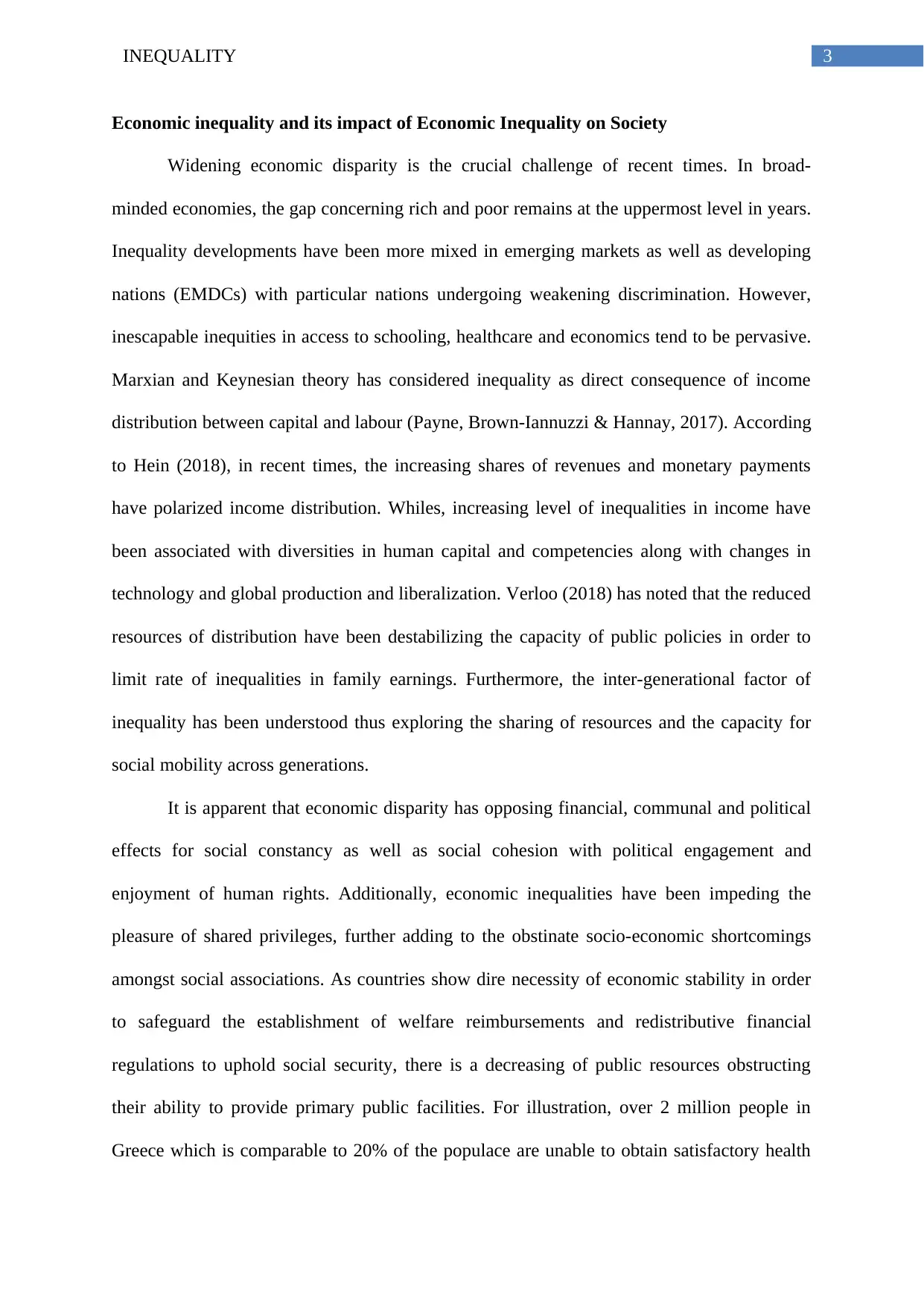
3INEQUALITY
Economic inequality and its impact of Economic Inequality on Society
Widening economic disparity is the crucial challenge of recent times. In broad-
minded economies, the gap concerning rich and poor remains at the uppermost level in years.
Inequality developments have been more mixed in emerging markets as well as developing
nations (EMDCs) with particular nations undergoing weakening discrimination. However,
inescapable inequities in access to schooling, healthcare and economics tend to be pervasive.
Marxian and Keynesian theory has considered inequality as direct consequence of income
distribution between capital and labour (Payne, Brown-Iannuzzi & Hannay, 2017). According
to Hein (2018), in recent times, the increasing shares of revenues and monetary payments
have polarized income distribution. Whiles, increasing level of inequalities in income have
been associated with diversities in human capital and competencies along with changes in
technology and global production and liberalization. Verloo (2018) has noted that the reduced
resources of distribution have been destabilizing the capacity of public policies in order to
limit rate of inequalities in family earnings. Furthermore, the inter-generational factor of
inequality has been understood thus exploring the sharing of resources and the capacity for
social mobility across generations.
It is apparent that economic disparity has opposing financial, communal and political
effects for social constancy as well as social cohesion with political engagement and
enjoyment of human rights. Additionally, economic inequalities have been impeding the
pleasure of shared privileges, further adding to the obstinate socio-economic shortcomings
amongst social associations. As countries show dire necessity of economic stability in order
to safeguard the establishment of welfare reimbursements and redistributive financial
regulations to uphold social security, there is a decreasing of public resources obstructing
their ability to provide primary public facilities. For illustration, over 2 million people in
Greece which is comparable to 20% of the populace are unable to obtain satisfactory health
Economic inequality and its impact of Economic Inequality on Society
Widening economic disparity is the crucial challenge of recent times. In broad-
minded economies, the gap concerning rich and poor remains at the uppermost level in years.
Inequality developments have been more mixed in emerging markets as well as developing
nations (EMDCs) with particular nations undergoing weakening discrimination. However,
inescapable inequities in access to schooling, healthcare and economics tend to be pervasive.
Marxian and Keynesian theory has considered inequality as direct consequence of income
distribution between capital and labour (Payne, Brown-Iannuzzi & Hannay, 2017). According
to Hein (2018), in recent times, the increasing shares of revenues and monetary payments
have polarized income distribution. Whiles, increasing level of inequalities in income have
been associated with diversities in human capital and competencies along with changes in
technology and global production and liberalization. Verloo (2018) has noted that the reduced
resources of distribution have been destabilizing the capacity of public policies in order to
limit rate of inequalities in family earnings. Furthermore, the inter-generational factor of
inequality has been understood thus exploring the sharing of resources and the capacity for
social mobility across generations.
It is apparent that economic disparity has opposing financial, communal and political
effects for social constancy as well as social cohesion with political engagement and
enjoyment of human rights. Additionally, economic inequalities have been impeding the
pleasure of shared privileges, further adding to the obstinate socio-economic shortcomings
amongst social associations. As countries show dire necessity of economic stability in order
to safeguard the establishment of welfare reimbursements and redistributive financial
regulations to uphold social security, there is a decreasing of public resources obstructing
their ability to provide primary public facilities. For illustration, over 2 million people in
Greece which is comparable to 20% of the populace are unable to obtain satisfactory health
Paraphrase This Document
Need a fresh take? Get an instant paraphrase of this document with our AI Paraphraser
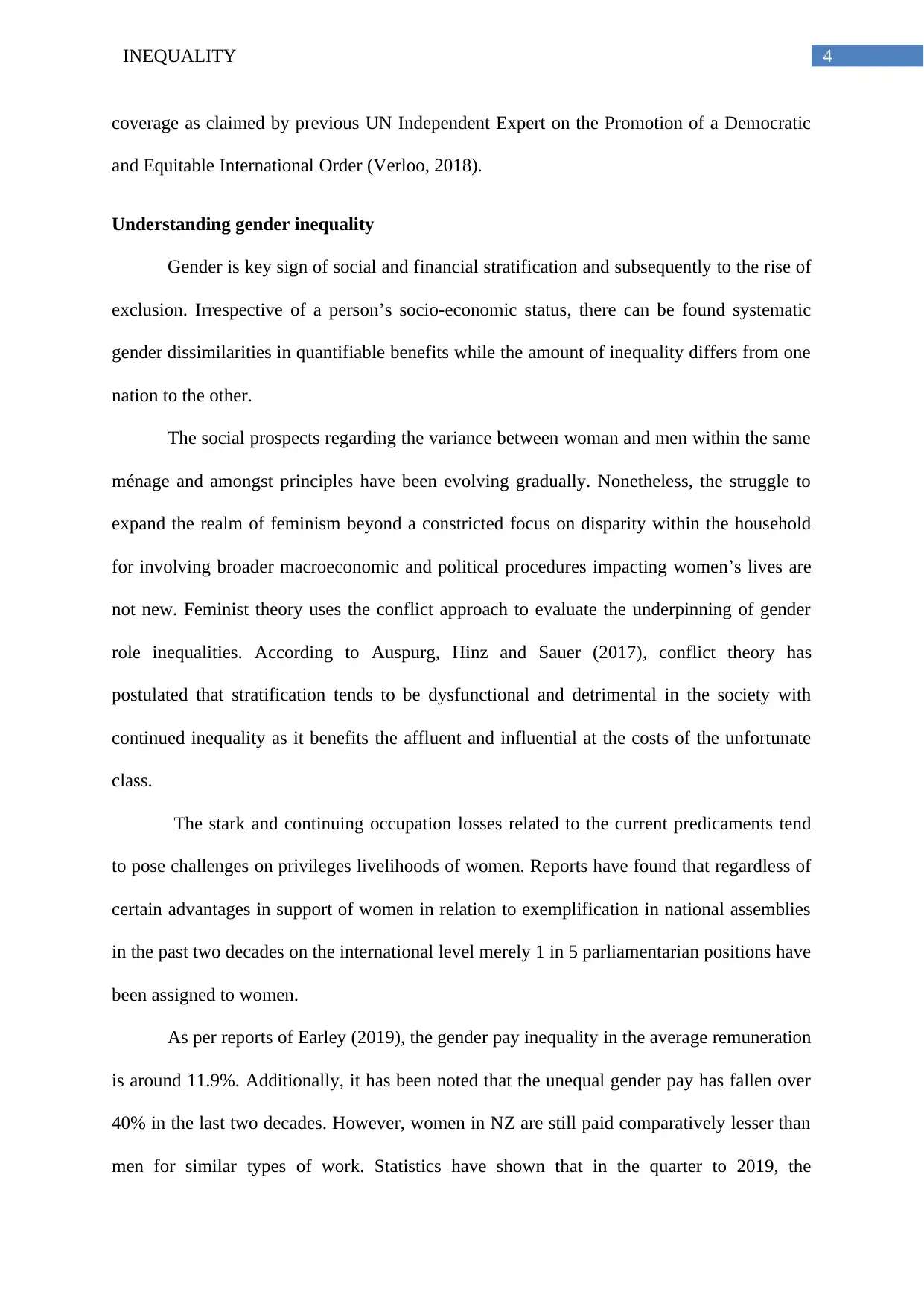
4INEQUALITY
coverage as claimed by previous UN Independent Expert on the Promotion of a Democratic
and Equitable International Order (Verloo, 2018).
Understanding gender inequality
Gender is key sign of social and financial stratification and subsequently to the rise of
exclusion. Irrespective of a person’s socio-economic status, there can be found systematic
gender dissimilarities in quantifiable benefits while the amount of inequality differs from one
nation to the other.
The social prospects regarding the variance between woman and men within the same
ménage and amongst principles have been evolving gradually. Nonetheless, the struggle to
expand the realm of feminism beyond a constricted focus on disparity within the household
for involving broader macroeconomic and political procedures impacting women’s lives are
not new. Feminist theory uses the conflict approach to evaluate the underpinning of gender
role inequalities. According to Auspurg, Hinz and Sauer (2017), conflict theory has
postulated that stratification tends to be dysfunctional and detrimental in the society with
continued inequality as it benefits the affluent and influential at the costs of the unfortunate
class.
The stark and continuing occupation losses related to the current predicaments tend
to pose challenges on privileges livelihoods of women. Reports have found that regardless of
certain advantages in support of women in relation to exemplification in national assemblies
in the past two decades on the international level merely 1 in 5 parliamentarian positions have
been assigned to women.
As per reports of Earley (2019), the gender pay inequality in the average remuneration
is around 11.9%. Additionally, it has been noted that the unequal gender pay has fallen over
40% in the last two decades. However, women in NZ are still paid comparatively lesser than
men for similar types of work. Statistics have shown that in the quarter to 2019, the
coverage as claimed by previous UN Independent Expert on the Promotion of a Democratic
and Equitable International Order (Verloo, 2018).
Understanding gender inequality
Gender is key sign of social and financial stratification and subsequently to the rise of
exclusion. Irrespective of a person’s socio-economic status, there can be found systematic
gender dissimilarities in quantifiable benefits while the amount of inequality differs from one
nation to the other.
The social prospects regarding the variance between woman and men within the same
ménage and amongst principles have been evolving gradually. Nonetheless, the struggle to
expand the realm of feminism beyond a constricted focus on disparity within the household
for involving broader macroeconomic and political procedures impacting women’s lives are
not new. Feminist theory uses the conflict approach to evaluate the underpinning of gender
role inequalities. According to Auspurg, Hinz and Sauer (2017), conflict theory has
postulated that stratification tends to be dysfunctional and detrimental in the society with
continued inequality as it benefits the affluent and influential at the costs of the unfortunate
class.
The stark and continuing occupation losses related to the current predicaments tend
to pose challenges on privileges livelihoods of women. Reports have found that regardless of
certain advantages in support of women in relation to exemplification in national assemblies
in the past two decades on the international level merely 1 in 5 parliamentarian positions have
been assigned to women.
As per reports of Earley (2019), the gender pay inequality in the average remuneration
is around 11.9%. Additionally, it has been noted that the unequal gender pay has fallen over
40% in the last two decades. However, women in NZ are still paid comparatively lesser than
men for similar types of work. Statistics have shown that in the quarter to 2019, the
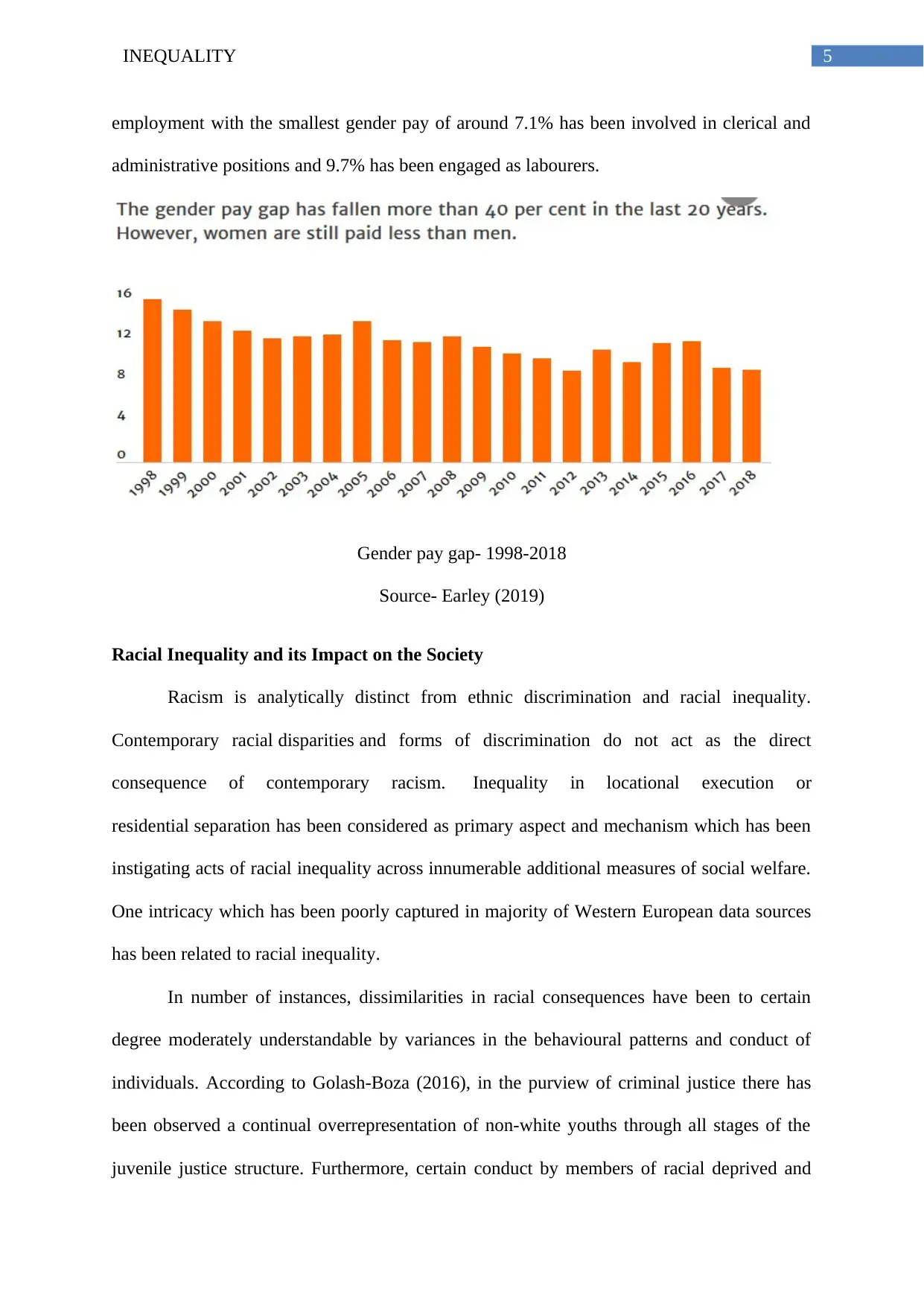
5INEQUALITY
employment with the smallest gender pay of around 7.1% has been involved in clerical and
administrative positions and 9.7% has been engaged as labourers.
Gender pay gap- 1998-2018
Source- Earley (2019)
Racial Inequality and its Impact on the Society
Racism is analytically distinct from ethnic discrimination and racial inequality.
Contemporary racial disparities and forms of discrimination do not act as the direct
consequence of contemporary racism. Inequality in locational execution or
residential separation has been considered as primary aspect and mechanism which has been
instigating acts of racial inequality across innumerable additional measures of social welfare.
One intricacy which has been poorly captured in majority of Western European data sources
has been related to racial inequality.
In number of instances, dissimilarities in racial consequences have been to certain
degree moderately understandable by variances in the behavioural patterns and conduct of
individuals. According to Golash-Boza (2016), in the purview of criminal justice there has
been observed a continual overrepresentation of non-white youths through all stages of the
juvenile justice structure. Furthermore, certain conduct by members of racial deprived and
employment with the smallest gender pay of around 7.1% has been involved in clerical and
administrative positions and 9.7% has been engaged as labourers.
Gender pay gap- 1998-2018
Source- Earley (2019)
Racial Inequality and its Impact on the Society
Racism is analytically distinct from ethnic discrimination and racial inequality.
Contemporary racial disparities and forms of discrimination do not act as the direct
consequence of contemporary racism. Inequality in locational execution or
residential separation has been considered as primary aspect and mechanism which has been
instigating acts of racial inequality across innumerable additional measures of social welfare.
One intricacy which has been poorly captured in majority of Western European data sources
has been related to racial inequality.
In number of instances, dissimilarities in racial consequences have been to certain
degree moderately understandable by variances in the behavioural patterns and conduct of
individuals. According to Golash-Boza (2016), in the purview of criminal justice there has
been observed a continual overrepresentation of non-white youths through all stages of the
juvenile justice structure. Furthermore, certain conduct by members of racial deprived and
⊘ This is a preview!⊘
Do you want full access?
Subscribe today to unlock all pages.

Trusted by 1+ million students worldwide
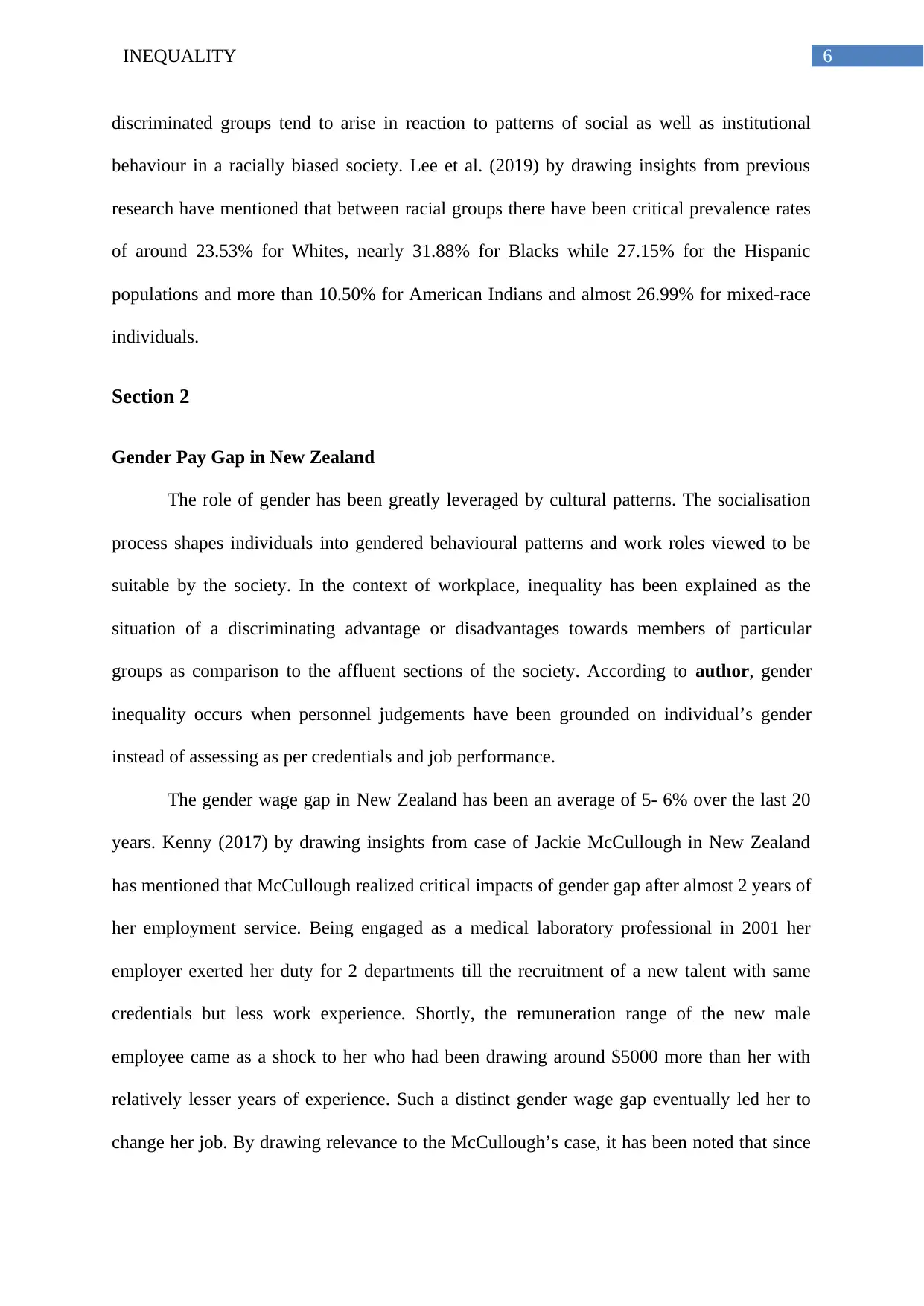
6INEQUALITY
discriminated groups tend to arise in reaction to patterns of social as well as institutional
behaviour in a racially biased society. Lee et al. (2019) by drawing insights from previous
research have mentioned that between racial groups there have been critical prevalence rates
of around 23.53% for Whites, nearly 31.88% for Blacks while 27.15% for the Hispanic
populations and more than 10.50% for American Indians and almost 26.99% for mixed-race
individuals.
Section 2
Gender Pay Gap in New Zealand
The role of gender has been greatly leveraged by cultural patterns. The socialisation
process shapes individuals into gendered behavioural patterns and work roles viewed to be
suitable by the society. In the context of workplace, inequality has been explained as the
situation of a discriminating advantage or disadvantages towards members of particular
groups as comparison to the affluent sections of the society. According to author, gender
inequality occurs when personnel judgements have been grounded on individual’s gender
instead of assessing as per credentials and job performance.
The gender wage gap in New Zealand has been an average of 5- 6% over the last 20
years. Kenny (2017) by drawing insights from case of Jackie McCullough in New Zealand
has mentioned that McCullough realized critical impacts of gender gap after almost 2 years of
her employment service. Being engaged as a medical laboratory professional in 2001 her
employer exerted her duty for 2 departments till the recruitment of a new talent with same
credentials but less work experience. Shortly, the remuneration range of the new male
employee came as a shock to her who had been drawing around $5000 more than her with
relatively lesser years of experience. Such a distinct gender wage gap eventually led her to
change her job. By drawing relevance to the McCullough’s case, it has been noted that since
discriminated groups tend to arise in reaction to patterns of social as well as institutional
behaviour in a racially biased society. Lee et al. (2019) by drawing insights from previous
research have mentioned that between racial groups there have been critical prevalence rates
of around 23.53% for Whites, nearly 31.88% for Blacks while 27.15% for the Hispanic
populations and more than 10.50% for American Indians and almost 26.99% for mixed-race
individuals.
Section 2
Gender Pay Gap in New Zealand
The role of gender has been greatly leveraged by cultural patterns. The socialisation
process shapes individuals into gendered behavioural patterns and work roles viewed to be
suitable by the society. In the context of workplace, inequality has been explained as the
situation of a discriminating advantage or disadvantages towards members of particular
groups as comparison to the affluent sections of the society. According to author, gender
inequality occurs when personnel judgements have been grounded on individual’s gender
instead of assessing as per credentials and job performance.
The gender wage gap in New Zealand has been an average of 5- 6% over the last 20
years. Kenny (2017) by drawing insights from case of Jackie McCullough in New Zealand
has mentioned that McCullough realized critical impacts of gender gap after almost 2 years of
her employment service. Being engaged as a medical laboratory professional in 2001 her
employer exerted her duty for 2 departments till the recruitment of a new talent with same
credentials but less work experience. Shortly, the remuneration range of the new male
employee came as a shock to her who had been drawing around $5000 more than her with
relatively lesser years of experience. Such a distinct gender wage gap eventually led her to
change her job. By drawing relevance to the McCullough’s case, it has been noted that since
Paraphrase This Document
Need a fresh take? Get an instant paraphrase of this document with our AI Paraphraser
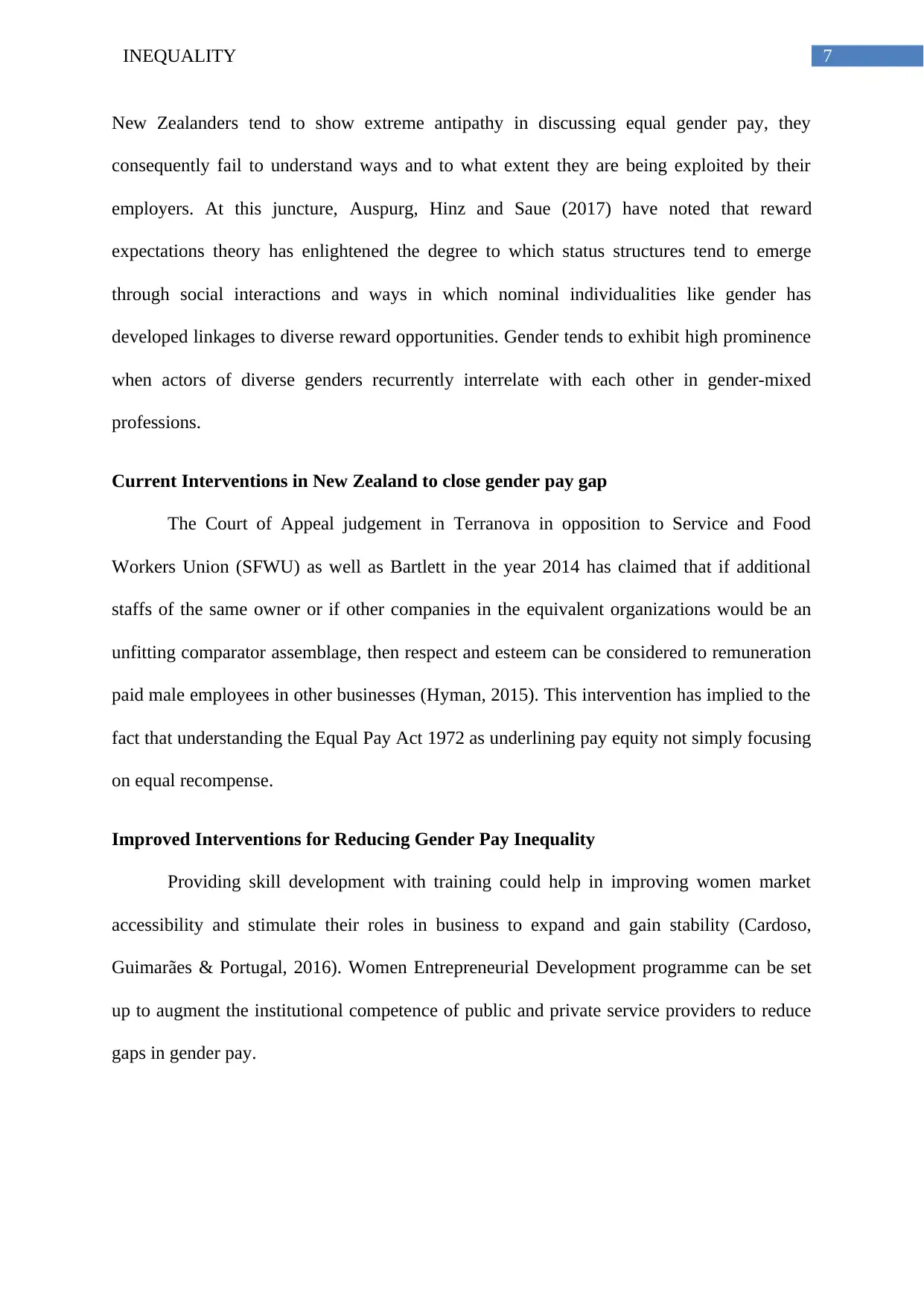
7INEQUALITY
New Zealanders tend to show extreme antipathy in discussing equal gender pay, they
consequently fail to understand ways and to what extent they are being exploited by their
employers. At this juncture, Auspurg, Hinz and Saue (2017) have noted that reward
expectations theory has enlightened the degree to which status structures tend to emerge
through social interactions and ways in which nominal individualities like gender has
developed linkages to diverse reward opportunities. Gender tends to exhibit high prominence
when actors of diverse genders recurrently interrelate with each other in gender-mixed
professions.
Current Interventions in New Zealand to close gender pay gap
The Court of Appeal judgement in Terranova in opposition to Service and Food
Workers Union (SFWU) as well as Bartlett in the year 2014 has claimed that if additional
staffs of the same owner or if other companies in the equivalent organizations would be an
unfitting comparator assemblage, then respect and esteem can be considered to remuneration
paid male employees in other businesses (Hyman, 2015). This intervention has implied to the
fact that understanding the Equal Pay Act 1972 as underlining pay equity not simply focusing
on equal recompense.
Improved Interventions for Reducing Gender Pay Inequality
Providing skill development with training could help in improving women market
accessibility and stimulate their roles in business to expand and gain stability (Cardoso,
Guimarães & Portugal, 2016). Women Entrepreneurial Development programme can be set
up to augment the institutional competence of public and private service providers to reduce
gaps in gender pay.
New Zealanders tend to show extreme antipathy in discussing equal gender pay, they
consequently fail to understand ways and to what extent they are being exploited by their
employers. At this juncture, Auspurg, Hinz and Saue (2017) have noted that reward
expectations theory has enlightened the degree to which status structures tend to emerge
through social interactions and ways in which nominal individualities like gender has
developed linkages to diverse reward opportunities. Gender tends to exhibit high prominence
when actors of diverse genders recurrently interrelate with each other in gender-mixed
professions.
Current Interventions in New Zealand to close gender pay gap
The Court of Appeal judgement in Terranova in opposition to Service and Food
Workers Union (SFWU) as well as Bartlett in the year 2014 has claimed that if additional
staffs of the same owner or if other companies in the equivalent organizations would be an
unfitting comparator assemblage, then respect and esteem can be considered to remuneration
paid male employees in other businesses (Hyman, 2015). This intervention has implied to the
fact that understanding the Equal Pay Act 1972 as underlining pay equity not simply focusing
on equal recompense.
Improved Interventions for Reducing Gender Pay Inequality
Providing skill development with training could help in improving women market
accessibility and stimulate their roles in business to expand and gain stability (Cardoso,
Guimarães & Portugal, 2016). Women Entrepreneurial Development programme can be set
up to augment the institutional competence of public and private service providers to reduce
gaps in gender pay.
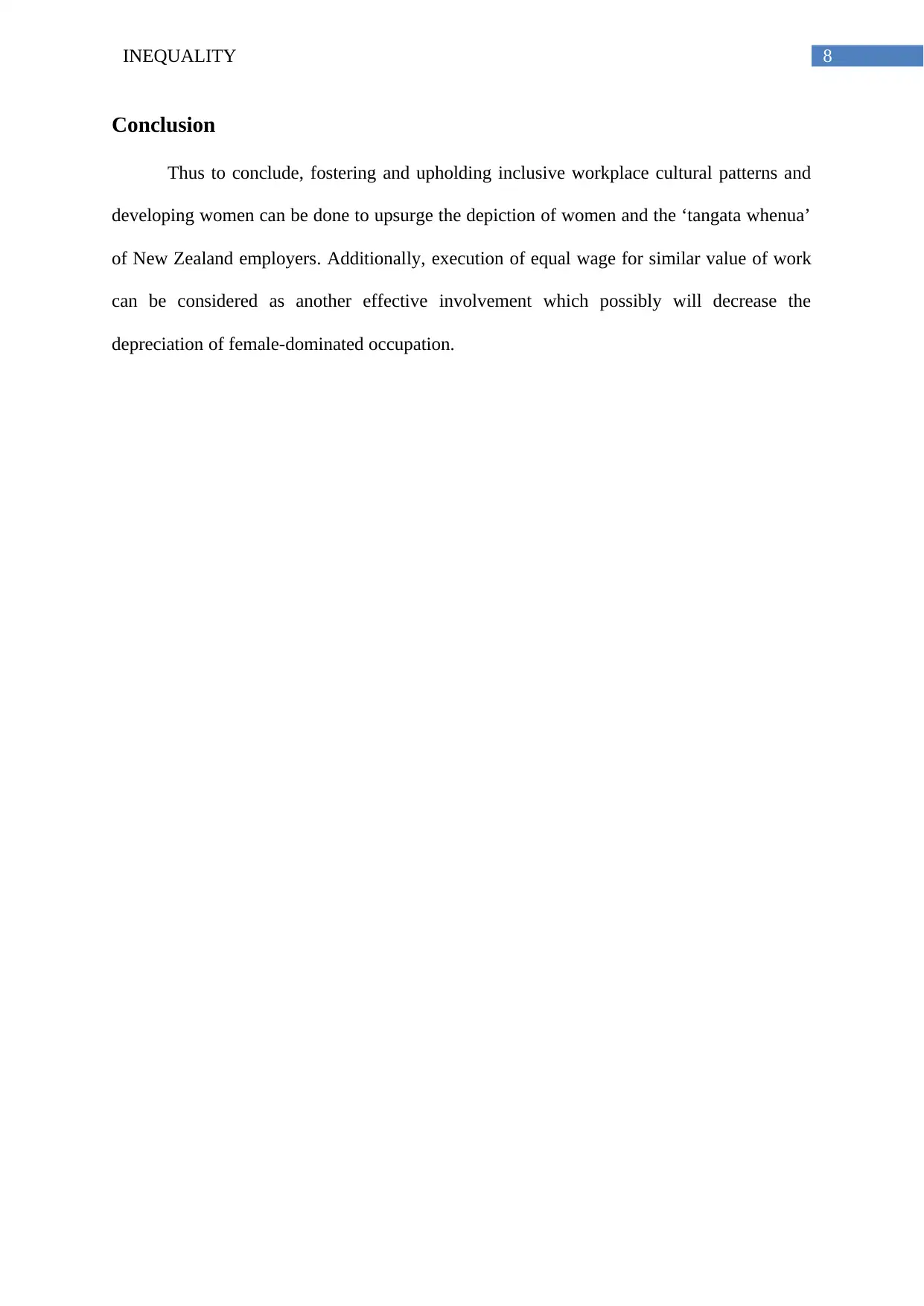
8INEQUALITY
Conclusion
Thus to conclude, fostering and upholding inclusive workplace cultural patterns and
developing women can be done to upsurge the depiction of women and the ‘tangata whenua’
of New Zealand employers. Additionally, execution of equal wage for similar value of work
can be considered as another effective involvement which possibly will decrease the
depreciation of female-dominated occupation.
Conclusion
Thus to conclude, fostering and upholding inclusive workplace cultural patterns and
developing women can be done to upsurge the depiction of women and the ‘tangata whenua’
of New Zealand employers. Additionally, execution of equal wage for similar value of work
can be considered as another effective involvement which possibly will decrease the
depreciation of female-dominated occupation.
⊘ This is a preview!⊘
Do you want full access?
Subscribe today to unlock all pages.

Trusted by 1+ million students worldwide
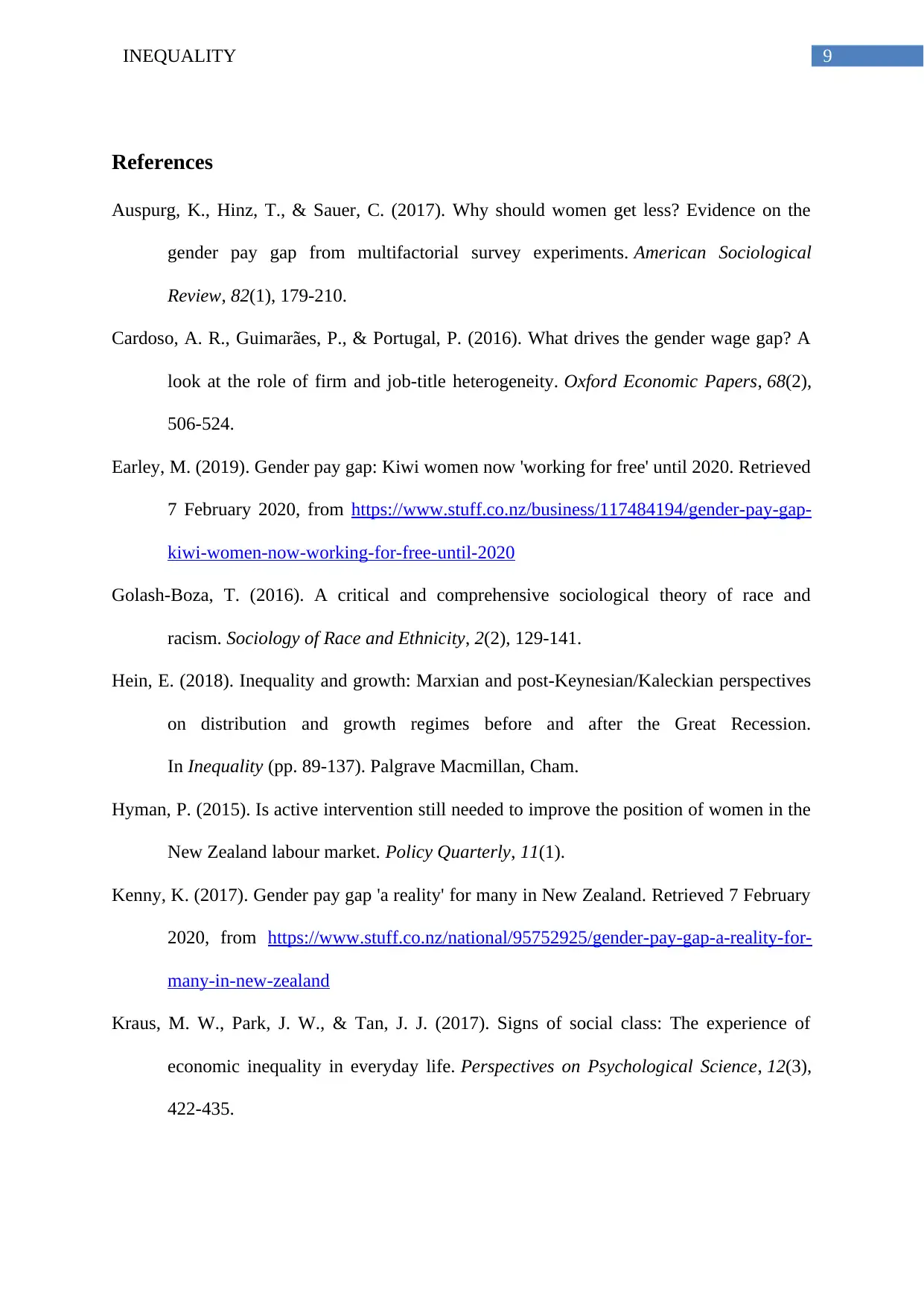
9INEQUALITY
References
Auspurg, K., Hinz, T., & Sauer, C. (2017). Why should women get less? Evidence on the
gender pay gap from multifactorial survey experiments. American Sociological
Review, 82(1), 179-210.
Cardoso, A. R., Guimarães, P., & Portugal, P. (2016). What drives the gender wage gap? A
look at the role of firm and job-title heterogeneity. Oxford Economic Papers, 68(2),
506-524.
Earley, M. (2019). Gender pay gap: Kiwi women now 'working for free' until 2020. Retrieved
7 February 2020, from https://www.stuff.co.nz/business/117484194/gender-pay-gap-
kiwi-women-now-working-for-free-until-2020
Golash-Boza, T. (2016). A critical and comprehensive sociological theory of race and
racism. Sociology of Race and Ethnicity, 2(2), 129-141.
Hein, E. (2018). Inequality and growth: Marxian and post-Keynesian/Kaleckian perspectives
on distribution and growth regimes before and after the Great Recession.
In Inequality (pp. 89-137). Palgrave Macmillan, Cham.
Hyman, P. (2015). Is active intervention still needed to improve the position of women in the
New Zealand labour market. Policy Quarterly, 11(1).
Kenny, K. (2017). Gender pay gap 'a reality' for many in New Zealand. Retrieved 7 February
2020, from https://www.stuff.co.nz/national/95752925/gender-pay-gap-a-reality-for-
many-in-new-zealand
Kraus, M. W., Park, J. W., & Tan, J. J. (2017). Signs of social class: The experience of
economic inequality in everyday life. Perspectives on Psychological Science, 12(3),
422-435.
References
Auspurg, K., Hinz, T., & Sauer, C. (2017). Why should women get less? Evidence on the
gender pay gap from multifactorial survey experiments. American Sociological
Review, 82(1), 179-210.
Cardoso, A. R., Guimarães, P., & Portugal, P. (2016). What drives the gender wage gap? A
look at the role of firm and job-title heterogeneity. Oxford Economic Papers, 68(2),
506-524.
Earley, M. (2019). Gender pay gap: Kiwi women now 'working for free' until 2020. Retrieved
7 February 2020, from https://www.stuff.co.nz/business/117484194/gender-pay-gap-
kiwi-women-now-working-for-free-until-2020
Golash-Boza, T. (2016). A critical and comprehensive sociological theory of race and
racism. Sociology of Race and Ethnicity, 2(2), 129-141.
Hein, E. (2018). Inequality and growth: Marxian and post-Keynesian/Kaleckian perspectives
on distribution and growth regimes before and after the Great Recession.
In Inequality (pp. 89-137). Palgrave Macmillan, Cham.
Hyman, P. (2015). Is active intervention still needed to improve the position of women in the
New Zealand labour market. Policy Quarterly, 11(1).
Kenny, K. (2017). Gender pay gap 'a reality' for many in New Zealand. Retrieved 7 February
2020, from https://www.stuff.co.nz/national/95752925/gender-pay-gap-a-reality-for-
many-in-new-zealand
Kraus, M. W., Park, J. W., & Tan, J. J. (2017). Signs of social class: The experience of
economic inequality in everyday life. Perspectives on Psychological Science, 12(3),
422-435.
Paraphrase This Document
Need a fresh take? Get an instant paraphrase of this document with our AI Paraphraser
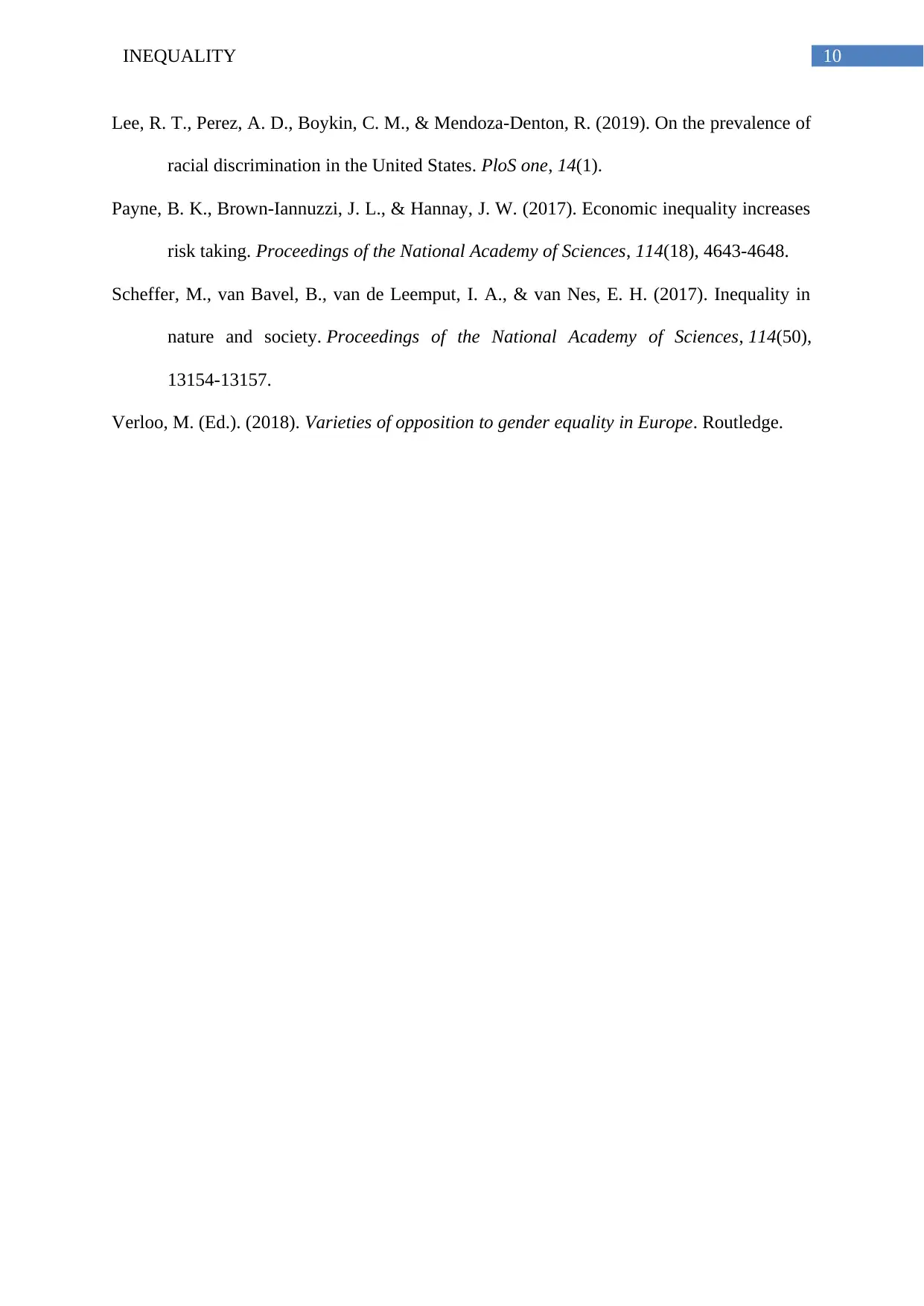
10INEQUALITY
Lee, R. T., Perez, A. D., Boykin, C. M., & Mendoza-Denton, R. (2019). On the prevalence of
racial discrimination in the United States. PloS one, 14(1).
Payne, B. K., Brown-Iannuzzi, J. L., & Hannay, J. W. (2017). Economic inequality increases
risk taking. Proceedings of the National Academy of Sciences, 114(18), 4643-4648.
Scheffer, M., van Bavel, B., van de Leemput, I. A., & van Nes, E. H. (2017). Inequality in
nature and society. Proceedings of the National Academy of Sciences, 114(50),
13154-13157.
Verloo, M. (Ed.). (2018). Varieties of opposition to gender equality in Europe. Routledge.
Lee, R. T., Perez, A. D., Boykin, C. M., & Mendoza-Denton, R. (2019). On the prevalence of
racial discrimination in the United States. PloS one, 14(1).
Payne, B. K., Brown-Iannuzzi, J. L., & Hannay, J. W. (2017). Economic inequality increases
risk taking. Proceedings of the National Academy of Sciences, 114(18), 4643-4648.
Scheffer, M., van Bavel, B., van de Leemput, I. A., & van Nes, E. H. (2017). Inequality in
nature and society. Proceedings of the National Academy of Sciences, 114(50),
13154-13157.
Verloo, M. (Ed.). (2018). Varieties of opposition to gender equality in Europe. Routledge.
1 out of 11
Related Documents
Your All-in-One AI-Powered Toolkit for Academic Success.
+13062052269
info@desklib.com
Available 24*7 on WhatsApp / Email
![[object Object]](/_next/static/media/star-bottom.7253800d.svg)
Unlock your academic potential
Copyright © 2020–2025 A2Z Services. All Rights Reserved. Developed and managed by ZUCOL.




